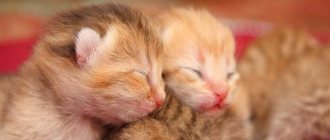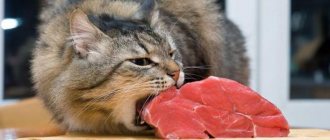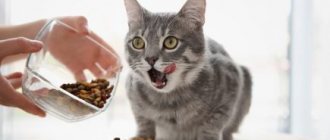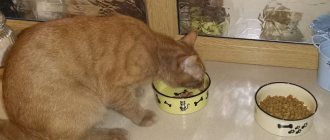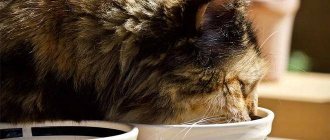What will you learn from the article?
- How to transfer a cat from dry food to wet food. What is the difficulty of the transfer?
- Step-by-step guide - how to switch a cat from a dry diet to a wet diet
- Useful tips
- Difficulties of switching to natural nutrition
- Useful tips
- How to wean a cat off whiskey and other economy-class food
- How to switch to a new kitten food
Sometimes cat owners are faced with the fact that their pet needs to be switched to another type of food. The reasons for this can be various: food allergies, intolerance to certain foods, switching to a premium brand of food, a veterinarian prescribing a therapeutic diet; a new stage in the pet's life.
Cats are very picky eaters, they have a sensitive gastrointestinal tract, so you can’t just switch them to a new type of food or brand of food overnight. The process of weaning off one food and getting accustomed to another is long and gradual. It requires endurance and patience from the owners.
In this article we will cover:
- how to wean a cat off the food he is used to;
- how to change the type of food without harming the cat’s health;
- how to switch your pet to a new brand of food.
How to switch a cat from dry food to wet food
Most often, cat owners are faced with the need to wean their cat off dry food and switch the pet to a wet diet. This process is especially difficult for animals that have been fed granulated industrial feed since birth. For them, changing their diet can be stressful.
Owners who are faced with the need to transfer their pet from a dry diet to wet canned food must competently approach the solution to this problem. Cats are hostage to their taste preferences; they may be reluctant to try new foods or go on a hunger strike.
What is the difficulty of translation?
A special feature of a diet based on wet food is that food is given 2-3 times a day. Anything that the cat hasn’t finished eating needs to be removed. Wet food cannot be kept in a bowl all day, it will spoil. Cats that are used to having dry kibble in their bowl all day may not immediately get used to this diet.
The second difficulty is that cats don’t like change. They find it difficult to transition from the hard, crunchy texture of kibble to the soft, moist texture of canned food. In addition, manufacturers of some brands of inexpensive food add additives to the granules, the taste of which animals really like.
Step-by-step guide - how to switch a cat from a dry diet to a wet diet
Step 1
We wean the cat off the fact that there is always dry food in the bowl. We divide the daily portion into 2-3 feedings and pour it in at a certain time for 20-30 minutes. We remove everything that the cat does not eat. The bowl should be empty and clean until the next meal. Only a bowl of water should be filled around the clock.
Cats, accustomed to a constantly filled bowl, may resist and beg for food with plaintive meows. Be firm and consistent, do not follow the animal's lead. Only fill the bowl when it is time to feed and remove any uneaten food. You can offer your cat some wet food between meals to familiarize him with it.
Why this step: many cats refuse to try new food if the bowl is constantly filled with dry food. It may take them 1-2 weeks just to get used to food being given out on a schedule.
Step 2
Once you have passed the first stage and noticed that the cat is accustomed to feeding on a schedule, proceed to a gradual change in diet.
Diet change formula:
- Day 1-2: 90% – dry food; 10% – wet food;
- 3-4 days: 75% – dry food; 25% – canned food;
- Day 5-6: 50% – granules; 50% – canned food;
- 7-8 days: 25% – dry food; 75% – wet;
- Day 9: 100% – wet canned food.
Some animals may need a longer time to adjust to the new diet. Do not rush your pets; proceed to the next stage only when the cat is ready.
Carefully monitor your pet's well-being and behavior during this period of time. At the slightest deviation from the norm, contact your veterinarian.
Stick to the indicated proportions, gradually increase and decrease the portion of the new food, do not try to accustom the animal to a changed diet in one day.
Useful tips
If your veterinarian recommends switching your pet to a wet diet, purchase a new food and be patient. Buying new food is the easiest part of the cat retraining process. To achieve success you will need: time, patience and some tricks.
- Be patient and be prepared for the training process to take from several weeks to 2-3 months.
- Purchase wet canned or bagged food from the same brand your pet is used to. This will help ensure proper digestion and keep the calorie content of food at the level the animal is accustomed to.
- If your cat is unfamiliar with wet food, help make it more appealing. Warm cooled food to room temperature. Make sure the food is not too hot - this will repel the animal.
- Offer canned food in a flat dish, or place some warm, wet food near your cat's bowl so your cat can lick it off easily.
- Don’t rush to switch your cat to a new food, do it smoothly and gradually.
- Reinforce the result with positive motivation for your pet. Gently call him to the bowl of food, talk to your pet, praise him every time the cat tries a new food.
- Crush the wet food with a fork, spreading it around the bowl so that the cat eats the food more slowly and does not swallow the food in one piece. Ingestion too quickly will negatively affect the animal's digestion.
Read: Is dry food bad for cats?
Video
How to switch a cat from dry food to natural food
Supporters of natural nutrition are often faced with the need to switch a cat from dry food to natural food. This happens when an adult pet is taken into the home from a shelter or a kitten that the breeder fed with industrial pelleted food.
To clarify, switching to natural food does not mean accustoming you to home-cooked food from your table. Human food is not designed to be fed to a cat. A pet’s natural diet is a specially developed diet that contains products that provide the animal with all the necessary substances.
Difficulties of switching to natural nutrition
- Pets accustomed to ready-made food may at first refuse natural products, not considering them edible.
- Owners will have to specially prepare food for their pets, carefully calculating the diet so that it contains all the necessary micro- and macroelements.
- Feeding “natural” provides for the additional introduction of vitamin and mineral complexes. Premium class industrial dry food has a balanced vitamin and mineral composition.
Step-by-step guide - how to switch a cat from dry food to natural food
Step 1
Once you have decided to change your pet's diet, visit your veterinarian. The doctor will assess the animal’s health, find out if there are any contraindications for such a diet, and recommend vitamin and mineral complexes. Health problems and old age of the cat may be a contraindication for a radical change in the type of diet.
Step 2
If your pet is used to having his bowl constantly filled with dry food, you will have to first train him to eat on a schedule. Without offering natural food, we divide the daily feeding rate into 2-3 servings. We fill the cat's bowl with dry food at certain times: morning, afternoon and evening. Anything the cat hasn’t eaten will be removed after half an hour.
Step 3
We move on to this stage only when the cat is accustomed to feeding “on the clock” and does not require food in between feedings. Each pet has its own pace, do not rush the animal. In the third step, we let the cat try wet food and teach it that food is not always dry. To begin with, you can soak the usual granules in water and offer them to the cat in this form.
Next, add natural products to the cat’s diet:
- First stage: 10% – natural products (chicken fillet, unsweetened cottage cheese); 90% – drying.
- Second stage: 20-25% – natural food (add rabbit meat, lean veal, chicken stomachs, boiled sea fish fillet); 80-75% – dry food.
- Third stage: 50% – natural; 50% – dry food.
- Stage four: 75% – natural food; 25% – granulated feed.
- Fifth stage: 100% natural nutrition.
Useful tips
- New products are being introduced gradually. You can offer your cat one new product every 3-4 days. This is necessary in order to observe the animal and evaluate how the pet’s body reacts to different foods.
- If you identify an allergy to a particular type of food, you should contact your veterinarian.
- Give meat products in finely chopped pieces - the cat must learn to chew such food.
- Give food strictly on time. After 15-30 minutes, remove the bowl of food so that the food does not turn sour. The animal must understand that you will not offer other food. Water should be available to the cat 24/7.
- Make sure that the transition to natural food is smooth; a sudden change in diet can provoke a hunger strike on the part of the animal and cause problems with the gastrointestinal tract.
- Do not keep dry industrial food in the house so that the cat does not smell it. Your cat's sensitive sense of smell will detect its familiar favorite aroma, even if you hide it.
- At the last stage, do not give in to pity, do not react to plaintive meows, and do not give the cat dry food.
It is unacceptable to mix natural food and dry food during one feeding - the cat’s gastrointestinal tract is not able to digest them at the same time.
Video
Sensitive stomach
You can understand that your pet has an overly sensitive stomach only after consulting a veterinarian. This must be done in order to differentiate hypersensitivity from food allergies or other diseases. Signs that your cat has a sensitive stomach and needs to change food are:
- eruption of gastric contents immediately after eating;
- disruption of the bowel movement in the form of constipation or diarrhea.
In addition to a sensitive stomach, the reason for changing food is the deterioration of the cat’s well-being. The owner may notice the appearance of an unpleasant odor from the animal’s mouth or tray. The causes of such symptoms are various pathologies, so it is important to give your cat a full examination at a veterinary clinic before changing food. Self-medication can be dangerous to the health of the animal.
How to wean a cat off wet food
The principles of weaning a cat off wet food are the same as in the cases discussed above:
- subsequence;
- phasing;
- monitoring how the animal tolerates new food.
A transfer from feeding wet canned food to “drying” can be caused by:
- veterinarian recommendations;
- The desire of the owners to improve the quality of the animal’s nutrition by switching the pet to super-premium food or “holistic food”.
The complete translation may take several weeks. First, the cat is offered dry granules soaked in water so that the animal becomes familiar with a new type of food. New food should be offered when the animal is hungry. A cat that has eaten its usual diet may not show interest in unusual food.
Further, the granules are offered in dry form; cats usually like the crunchy texture of this food and crunch with pleasure. For some pets, the new taste and texture may seem too unusual - they will refuse to “dry”. Don't worry about this, give your cat time to get acquainted and get used to the new food.
Useful tips
- Carefully monitor the animal's reaction, make sure that the cat eats, do not allow a complete hunger strike - this is dangerous for the liver.
- Feed by the hour. At the initial stage, you should not pour food into a bowl and keep it there all day. Give out food in portions at strictly prescribed times.
- Be patient, don't rush your cat, reward him every time he agrees to try a new food.
Make sure your cat has 24/7 access to clean, fresh drinking water. Animals on a dry diet must receive sufficient fluid.
Video
The period after castration or sterilization
After this procedure, most cats begin to overeat. This reaction is associated with less activity, since before this they had to look for a partner.
Naturally, castration or sterilization itself does not affect weight gain. Incorrectly selected food has an effect.
Try to start switching your pet to special food immediately after the procedure. Add a little to regular food, special food, gradually removing regular food from the mixture. In specialized foods, the amount of fat is reduced, which will have a beneficial effect on the pet’s health.
How to switch a cat to another food
It may seem that the simplest situation is when the owners do not change the type of food (dry, wet), but simply decided for certain reasons to change the brand. This is a misconception; transferring an animal from one brand to another also requires time and patience of the owners.
Reasons for transferring to another brand:
- transition of a kitten to an adult age group;
- medical indications (therapeutic and prophylactic brands);
- pregnancy;
- sterilization, castration;
- recovery in the postoperative period;
- identifying intolerance to certain foods;
- advanced age;
- allergy;
- transfer to a premium brand (super-premium, holistic);
- The brand of food that the cat is accustomed to has been discontinued.
New cat food is introduced into the menu gradually over 10-12 days. In the first 1-2 days, offer the animal only 20% of the new brand of food. The rest of the serving should be the pet’s usual food. Increase the amount of new food in the diet by 10% every day until you reach 100%.
Throughout the transition period, carefully monitor the condition of the animal. If you notice allergic reactions, signs of gastrointestinal upset, changes in behavior, stop giving new food and show the animal to a veterinarian.
How to wean a cat off whiskey and other economy-class food
This can be difficult. Manufacturers of economy-class food add artificial flavors, dyes and taste enhancers. Therefore, many cats quickly get used to such food and are very fond of cheap food from supermarkets.
However, such food can be harmful to your pet's health. The composition of these brands is not sufficiently balanced; these foods contain little protein but a lot of carbohydrates. Economy brands, such as Whiskas, Kiteket, Friskies, have low energy value; cats need to eat large portions to get enough.
Owners will need time and patience to change their pet's taste preferences. This cannot be achieved in one day. You need to tune in little by little and gradually add new food of better quality to the diet. The cat may ignore it, choose an old brand of granules, or leave new food of an unusual taste in the bowl.
You need to patiently offer your cat food of a new brand, calmly and restrainedly treat its whims and pitiful meows. When the animal understands that there will be no other food, it will have to eat what is given. The owner’s task is to calmly react to possible failures and praise the pet if he has at least tried a new taste.
Video
Change in coat condition
The reason to change your pet's food is also a change in the condition of the coat. With an incorrectly selected diet, lack of vitamins and minerals, the wool is the first to suffer. Skin and coat are a kind of indicators of the internal state of the body. Brittle, thin hair, areas of bald patches on a cat’s body are a reason not only to change the diet, but also to identify the underlying factor. Perhaps, in addition to the diet, it will be necessary to give your pet special complexes to maintain a healthy coat.
How to help your cat switch to a new food
- Feed your cat in a quiet, private place, away from people and other pets.
- Offer new food to your cat by hand.
- Talk kindly to your animal when giving him new food. Praise when your cat tries even a piece.
- Slightly warmed food smells more fragrant, try heating new food to increase its attractiveness in the eyes of your pet.
- If your cat likes the fishy smell, you can add a little tuna oil to the food.
- Mix new food with old food so that the cat does not have the opportunity to choose the usual food and refuse the unfamiliar.
- The main rule is that if a cat refuses new food, do not let him starve. Go back to the old food and try to switch to the new diet a little later.
- Experiment with different tastes, find the taste that your cat likes best.
Obesity
Obese cats become frequent patients in veterinary clinics. And recently their number has been growing. Compassionate owners pour food for the animal based on their own observations or desires. It is especially often transmitted by cats receiving dry food. Visually, it seems to the owner that the portion is too small or that they are giving additional food from their table. In addition to obesity, such animals have a number of pathologies in their internal organs. To prevent this, it is necessary to observe both the dosage and feeding regimen. Veterinary nutritionists select food based on the individual characteristics of the patient.
Features of switching cats to another food at different periods of life
At different stages of a cat's life, the process of transferring to a new diet should be structured differently. It is important to choose the right time and choose the most suitable methods of accustoming to new food.
How to switch to a new kitten food
Kittens are switched to adult brands of food at 12 months of age. This must be done because older pets require more nutrients. The composition of brands marked “for kittens” is not suitable for adult cats.
Curious kittens love to discover new things, including tastes, aromas and textures. They may enthusiastically eat new types of food. Maintain your kitten's enthusiasm with a positive attitude, praise and affection. This positive experience will help in the future, if necessary, to wean the cat off food and switch it to other products.
Don't rush your pet. Even if he willingly eats new food. Give his digestive system the opportunity to readjust and get used to the changed composition. Gradually introduce new food over 5-7 days, gradually adding it to the usual food.
The transition from kitten food to an adult diet should be smooth and easy. Throughout the transfer period, make sure that the kitten has clean drinking water, monitor its appetite, stool and well-being. This will help determine the cat’s attitude towards new food and tell you about its health.
How to change the diet of shelter cats
Once you adopt an adult cat from a shelter, it can be tempting to quickly switch her to a different, better quality food. On the one hand, this desire is understandable - shelter food is usually not distinguished by quality and balance.
On the other hand, a cat that finds itself in a new environment experiences severe stress. Because of this, he may have digestive problems. Veterinarians recommend feeding the animal the food it is accustomed to for the first month. And only then try to gradually change your diet.
Sources:
- https://www.hillspet.com/cat-care/nutrition-feeding/switching-cat-food
- https://www.veazievet.com/feline-wellness/adult-cat-wellness/food-choices-maintaining-a-healthy-weight/transitioning-your-dry-food-junkie-to-a-wet-food- connoisseur/
- https://veterinarypartner.vin.com/default.aspx?pid=19239&catId=102902&id=4952909
- https://www.darwinspet.com/resources/transitioning/cat.html
- https://www.askthecatdoctor.com/switching-cat-food-brands.html
